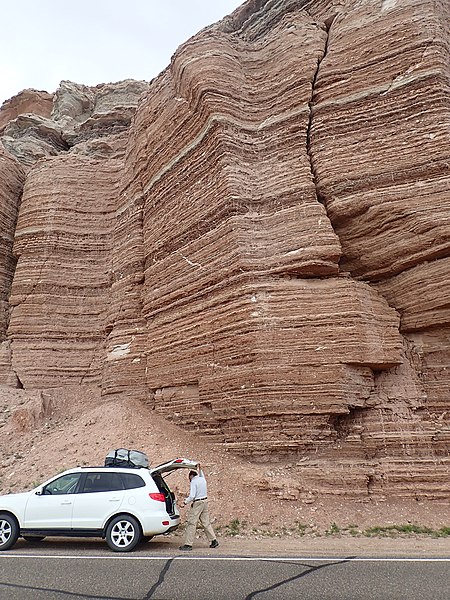A geological formation, or simply formation, is a body of rock having a consistent set of physical characteristics (lithology) that distinguishes it from adjacent bodies of rock, and which occupies a particular position in the layers of rock exposed in a geographical region. It is the fundamental unit of lithostratigraphy, the study of strata or rock layers.
A geologic cross section of the Grand Canyon. Black numbers correspond to groups of formations and white numbers correspond to formations (click on picture for more information)
The Permian through Jurassic strata of the Colorado Plateau area of southeastern Utah demonstrate the principles of stratigraphy. These strata make up much of the famous prominent rock formations in widely spaced protected areas such as Capitol Reef National Park and Canyonlands National Park. From top to bottom: Rounded tan domes of the Navajo Sandstone, layered red Kayenta Formation, cliff-forming, vertically jointed, red Wingate Sandstone, slope-forming, purplish
Uluru (Ayers Rock) in Australia is underlain by the Mutitjulu Arkose, a formation composed almost entirely of a single lithology (arkosic sandstone).
The Summerville Formation is composed of alternating thin beds of two lithologies, mudstone and sandstone, penetrated by veins of a third lithology, gypsum.
Lithostratigraphy is a sub-discipline of stratigraphy, the geological science associated with the study of strata or rock layers. Major focuses include geochronology, comparative geology, and petrology.
The Permian through Jurassic lithostratigraphy of the Colorado Plateau area of southeastern Utah that makes up much of the famous prominent rock formations in protected areas such as Capitol Reef National Park and Canyonlands National Park. From top to bottom: Rounded tan domes of the Navajo Sandstone, layered red Kayenta Formation, cliff-forming, vertically jointed, red Wingate Sandstone, slope-forming, purplish Chinle Formation, layered, lighter-red
Strata in Salta (Argentina)
Diagrams showing stratigraphic relations: A: an angular unconformity; B: a disconformity; C: a nonconformity.
Disconformity with the Lower Cretaceous Edwards Formation overlying a Lower Permian limestone; hiatus is about 165 million years; Texas.







